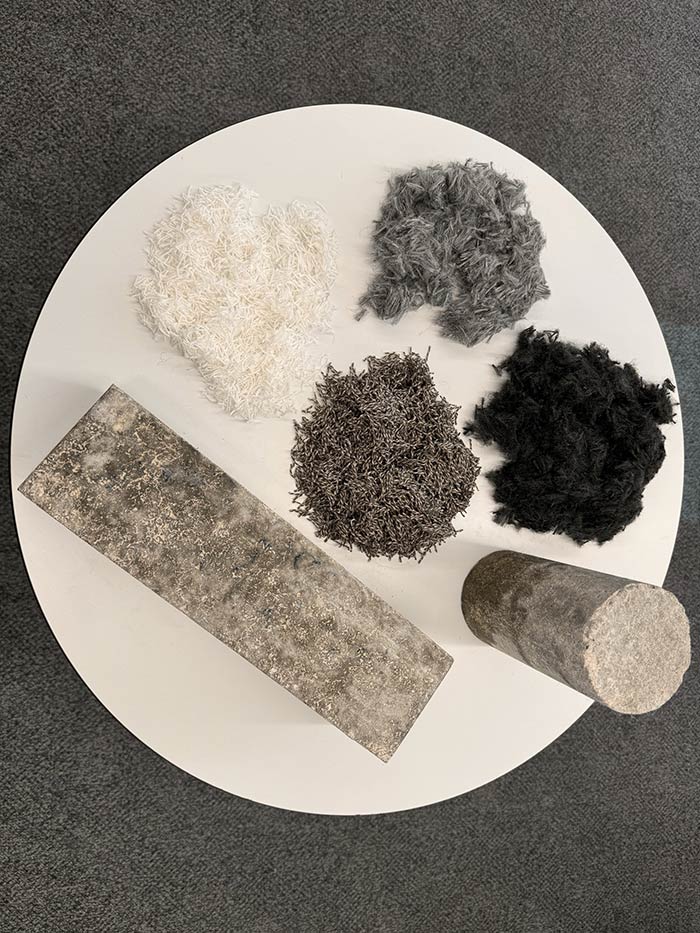Researchers from RMIT University have revealed encouraging results from a study that used scrap carpet fibres to produce stronger and crack-resistant concrete, opening up the potential for recycling discarded textile materials and creating new opportunities for sustainability in the construction sector.
The research team is engaging with partners including Textile Recyclers Australia, Godfrey Hirst Australia and councils in Victoria to conduct field studies of on-ground slabs made of reclaimed textiles.
Lead researcher Dr Chamila Gunasekara from RMIT University says the team had developed a technique using waste carpet fibres to reduce early-age shrinkage cracking in concrete by up to 30%, while also improving the concrete’s durability.
The annual cost of repairing cracks in reinforced concrete structures in Australia is about A$8 billion. In the US, the cost is estimated at US$76 billion per year.
Publishing their latest results in the Construction and Building Materials journal, the team has shown that waste carpet material can be used to improve concrete, addressing a major challenge in the construction sector. The team of civil engineers and textile researchers also used other discarded textiles including clothing fabrics to make concrete stronger.
“Cracking in early-age concrete slabs is a longstanding challenge in construction projects that can cause premature corrosion, not only making a building look bad but also risking its structural integrity and safety,” said Gunasekara, an ARC DECRA fellow from the School of Engineering.
“Scrap carpet fibres can be used to increase concrete’s strength by 40% in tension and prevent early cracking, by reducing shrinkage substantially,” he says.

Concrete samples made with carpet fibres
Laboratory concrete samples created using the various textile materials are shown to meet Australian Standards for engineering performance and environmental requirements.
Addressing a big waste challenge
The disposal of carpets and other textiles including discarded fabrics poses an enormous environmental challenge, Gunasekara said.
“Australia is the second largest consumer of textiles per person in the world, after the US. The average Australian purchases 27kg of new clothing and textiles every year, and discards 23kg into landfill,” he says.
“Burning carpet waste releases various toxic gases, creating environmental concerns.”
Dr Shadi Houshyar, a textile and material scientist at RMIT, says firefighting clothes waste also posed a challenge, as the same qualities that made these materials ideal for firefighting also made them difficult to recycle.

The research team with a pile of discarded clothes that could be used in their concrete. Credit: Will Wright, RMIT University
“Up to 70% of textile waste would be suitable for conversion into usable fibres, presenting an opportunity in the materials supply chain,” says Houshyar, from the School of Engineering.
Working with industry and government to support the recycling of waste
Field trials conducted with support from industry and local government partners will help capture the unexpected conditions encountered in real-world construction projects.
The ARC Industrial Transformation Research Hub for Transformation of Reclaimed Waste Resources to Engineered Materials and Solutions for a Circular Economy (TREMS) and an early-career research grant will fund the field trials as well as computational modelling. TREMS is led by Professor Sujeeva Setunge from RMIT.
The team is collaborating with Professor Andrzej Cwirzen from the Luleå University of Technology in Sweden on computational modelling.
‘Enhancement of concrete performance and sustainability through incorporation of diverse waste carpet fibres’ is published in Construction and Building Materials (DOI: 10.1016/j.conbuildmat.2024.137921).
Main image: Concrete samples made with carpet fibres. Credit: RMIT University

